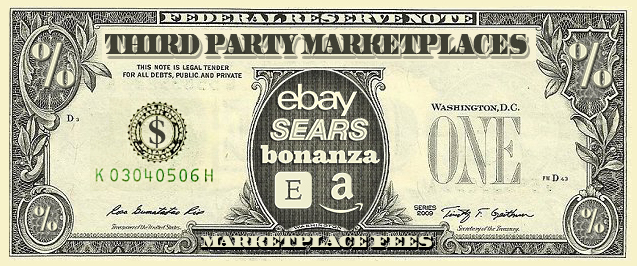
Third Party Marketplace Fees to Consider When Selling Online
Selling your merchandise through third party retailers is a great deal for many reasons. You get instant exposure and credibility, and you’re able to execute transactions with a minimal amount of effort. Of course, the ease and convenience of these retailers comes at a cost.
Here’s a look at the fees charged by the top 5 retailers we considered in our previous blog article and how those fees could impact your potential success on each site.

Amazon
Fees: 8% referral fee per transaction (minimum $1), $39.99 fee for filling more than 40 orders per month
Amazon is the leader in the industry. They’ve got the biggest reach and the highest customer satisfaction. However, for every jewelry sale you make with Amazon, you’ll give 8 percent right back to the site. Furthermore, if you sell more than 40 items a month on Amazon, you’ll also have to pay a monthly subscription fee of $39.99.
Is it worth it? Based on the exposure Amazon provides and its reputation as the first place people look for pretty much anything, you’d be foolish not to list on Amazon. The 8 percent might be a bit tough to swallow at times, but the 92 percent of sales going into your pocket will quell your concerns. Besides, plenty of sites with much smaller audiences charge a whole lot more.

eBay
eBay is second only to Amazon in terms of a long-standing reputation as a Web sales leader. Millions of people sell goods on eBay each day, and they do so gladly in spite of the fees the site charges. For each jewelry item you sell, you’ll have to give 10% of the final item price -- that is, the amount at which the auction ended -- to eBay. Similar to Amazon, more business means more fees, but eBay’s costs are more manageable in this area. After your 100th listing in a given month, you’ll have to pay 30 cents for each of your subsequent listings.
Compared with Amazon, the additional two percent you pay on eBay might scare you off a little. Make no mistake, ten percent is a pretty penny. But given eBay’s massive popularity and traffic, it’s definitely worth a thought. eBay isn’t for everyone, especially since you never really know what you’re going to get for an item until the auction ends (unless you use Buy it Now). However, you have 100 free listings a month to try it out so you can see for yourself.

Etsy
Fees: 3.5% fee per sale plus 3% credit card processing fee, $0.20 to list an item
Etsy is one of the fastest growing commerce sites on the Web, providing smaller companies the opportunity to open their own stores within a larger site. Many people have had success on Etsy, with one reason being the reasonable fees charged by the site. Etsy charges just 3.5 percent per item sold, the lowest of all the sites profiled here. Unfortunately, the fees don’t end there. Etsy charges another 3 percent for payment processing of Direct Checkout orders, plus a $0.25 flat fee. Lastly, you’ll have to pay 20 cents for each item you list.
Even with the extra fees, Etsy is still reasonably priced for selling purposes. And it’s a great place to list because Etsy specializes in handmade goods. The combination of knowledgeable, motivated customers and an inoffensive fee structure makes Etsy a good place to sell religious jewelry.

Sears
Fees: 20% fee per transaction, $39.99 monthly fee
Sears opened its own marketplace in order to revitalize the sagging Sears brand. It hasn’t saved the company just yet, but the marketplace does give retailers the option to have their merchandise featured alongside the rest of the Sears catalog. This right comes at a fairly steep cost. Retailers must pay a $39.99 monthly fee for the right to list their merchandise on the Sears marketplace. Furthermore, jewelry sales are subject to a 20% commission. That means a $100 sale only nets you $80.
Despite being linked to a major retailer, the Sears marketplace isn’t particularly well-known. The fees to list there are astronomical. You could get a great deal more exposure on Amazon or eBay, and pay a lot less in the process. If you are starting to venture out to the third-party marketplaces world, it is recommended you not start with Sears, as it could cost you to gain the experience of selling online. On the other hand, if you have some experience selling on third-party marketplaces, the Sears marketplace represents an opportunity to broaden your sales channels.
Bonanza
Our last profiled site is the newest and least well-known of the five, but Bonanza is a site with potential. And when you look at the fee structure, you’ll see why. Like Etsy, Bonanza charges a 3.5% fee, but there are no additional credit card processing or posting fees. The 3.5% fee only applies for orders under $500; for bigger orders, you’ll pay a 1.5% commission on the amount over $500, plus a $17.50 flat fee. Lastly, Bonanza offers sellers a shipping fee exemption of $10, which means you pay the fee on $10 less than the final item price as long as it’s not a free shipping item.
Now, Bonanza isn’t a very well-known site, and putting all of your eggs into its basket is probably not a great idea. However, with its low fees, it’s a site that will surely rise in popularity. You’d do well to consider listing your items on Bonanza now so that you can enjoy the low fees; it’s also a good idea to get in on the ground floor of what could become a lucrative partner.
Ultimately, the decision of which third party retailers to use is in your hands. Having said that, some facts should jump out at you. Amazon’s massive popularity means that you should utilize the site no matter what, and the fact that its fees are reasonable should only hasten your decision. On the other hand, Sears charges such high fees and gives little in terms of exposure, so it shouldn’t take long for you to rule it out as a viable option if you are just starting up.
The other sites are a little bit more tricky. eBay’s auction model, should you utilize it, could be troublesome for some companies. Etsy and Bonanza are smaller sites, but could work well given their low fees and user customization capabilities. With no long-term commitment required at any site, you can easily start gaining experience and you just may find yourself enjoying multiple revenue streams and having more success than ever.
Happy online selling!
If you are considering selling online, which marketplace are you going to start with? Share with us your opinions and experiences of selling on third-party marketplaces!


 Fees:
Fees: 
